Research projects
High-speed flows
- High-velocity air-water flows in low-level outlets: from laboratory to prototype scale
- Uplift Mechanism and Modelling of Offset Slabs in High-Speed Flows
Hydraulic structures
- Application of a new distributed fiber-optic pressure sensor in large scale hydraulic experiments
- Internal erosion detection in dikes and earthen embankments using distributed fiber optics (DFO) technology
- SmallFLEX Goms: Run-of-river Hydropower Flexibility and Complementarity with Photovoltaic Production in Goms Region
Hydroabrasion and sediment monitoring
- Controlled fine sediment venting via waterways of storage hydropower plants with Francis turbines as a strategy to counter reservoir sedimentation (SedVent)
- Field monitoring of sediment transport, hydraulics and hydro-abrasion at Swiss Sediment Bypass Tunnels
Ethohydraulics
- Advanced Bypass System for Downstream Migration of European Key Umbrella Fish Species (ABSYS)
- Electrified bar racks for fish protection at hydropower plants - risk of internal injuries due to the electric field
- Electrified fish protection structures for safe downstream fish passage at water intakes
- Herrentöbeli power plant: Hydraulic field measurements to monitor the technical effectiveness of the fish downstream migration facility
- Turbulent eddies to create paths for safe downstream migration for salmonids and eel (FishPath)

Reservoir dams are essential components of water resource management, serving multiple purposes such as hydropower, flood control, irrigation, and water supply. Low-level outlets (LLOs) are critical safety structures that enable rapid reservoir drawdown during emergencies or maintenance operations. However, the high-velocity, highly turbulent flows within LLOs can lead to cavitation and gate vibrations, which are common failure mechanisms potentially resulting in severe structural damage, uncontrolled water release, and downstream flooding. Therefore, proper air vent design is crucial to mitigate these risks by preventing excessive sub-atmospheric pressures within the tunnel.
Recent large-scale physical model studies have investigated the effects of tunnel and air vent geometries on air demand, flow patterns, and air-water flow properties in LLOs (i.e., Pagliara, 2025). These studies have led to new design guidelines and advanced the understanding of high-velocity air–water flows. Nevertheless, available prototype datasets remain limited and inconsistent, preventing a quantitative assessment of scale effects and a full validation of laboratory-derived equations.
To address this knowledge gap, a prototype-scale measurement campaign is carried out at the newly constructed Spitallamm Dam in Switzerland, completed in spring 2025. This large, double-curvature, concrete dam has a maximum height of 113 m, with a planned future heightening of 23 m, and is located at approximately 1’900 m above sea level. The first reservoir impounding and associated loading tests in Summer 2025 provides a unique opportunity to collect high-quality prototype data from the dam’s main LLO. It was possible to draw on the experiences and findings of the field measurement campaigns in the bottom outlet of the Luzzone arch dam in 2019 and 2020 (Hohermuth et al., 2021).
The experimental setup includes vane anemometers and pressure sensors to quantify air demand, dual-tip phase-detection conductivity probes to measure air–water flow properties, video cameras to document flow patterns, and a LiDAR system for independent validation of the probe measurements (see figure). Data are collected under extreme hydraulic conditions, with flow velocities exceeding 40 m/s and Reynolds numbers greater than 10⁷, which pose significant technical and safety challenges.
This project provides an unprecedented dataset on air demand and air-water flow properties in a prototype LLO. Additionally, by documenting both technical approaches and practical challenges, guidance is provided for researchers in planning and executing similar large-scale measurement campaigns, which are essential for validating laboratory findings and, ultimately, for advancing the safe design of large dams.
VAW gratefully acknowledge Kraftwerke Oberhasli AG (KWO) and Grimsel Hydro for providing the opportunity to conduct this experimental campaign and for their invaluable support during the installation, deinstallation, and execution of the measurements.

The test campaign conducted at the Large Wave Current Flume (Grosser Wel-lenströmungskanal – GWK+) in Hannover aimed to evaluate a new Distributed Pressure Sensor (DPS) technology developed by the Eastern University of Applied Sciences of Rapperswil (OST) in a real-scale wave environment and to compare its performance against conventional wave-measuring equipment. Two complementary optical interro-gation systems were used: a Rayleigh-based ODiSI system and a Distributed Acoustic Sensing (DAS) system, enabling the assessment of pressure-sensing accuracy, robust-ness, and the DPS’s integration potential for early-warning systems and general wave-monitoring applications.
The DPS cable consists of a multilayer construction featuring high-strength aramid fi-bers, a helix-configured single-mode fiber for pressure measurement, and multiple opti-cal fibers for multimodal sensing. The cable was installed in the middle of the wave channel, securely mounted to ensure stable positioning during the tests. For validation, four Resistance Wave Gauges (WG), which were already installed in the flume, were used to provide conventional reference measurements of the water surface elevation.
Testing followed a three-phase procedure: (1) filling the flume, (2) running nine wave generation scenarios with varying configurations, and (3) emptying the flume. During these tests, multiple interrogators operated simultaneously: Wave gauges and a pres-sure sensor for conventional data; Raman-based DFO for temperature observations; ODiSI for DP-based pressure sensing; and a DAS interrogator (SINTELA Onyx) for high-resolution distributed pressure data.
The analysis phase will include calibrating the DPS against WG measurements, compar-ing wave parameters (height, velocity, period) derived from the ODiSI and DAS systems, and evaluating overall sensor performance. The final discussion will assess the DPS’s potential for integration into operational wave-monitoring and early-warning infrastruc-tures.
Overall, the tests represent an important step in validating a novel distributed sensing technology capable of providing continuous spatial pressure measurements along large structures or basins, offering promising advantages over traditional point-based in-struments.
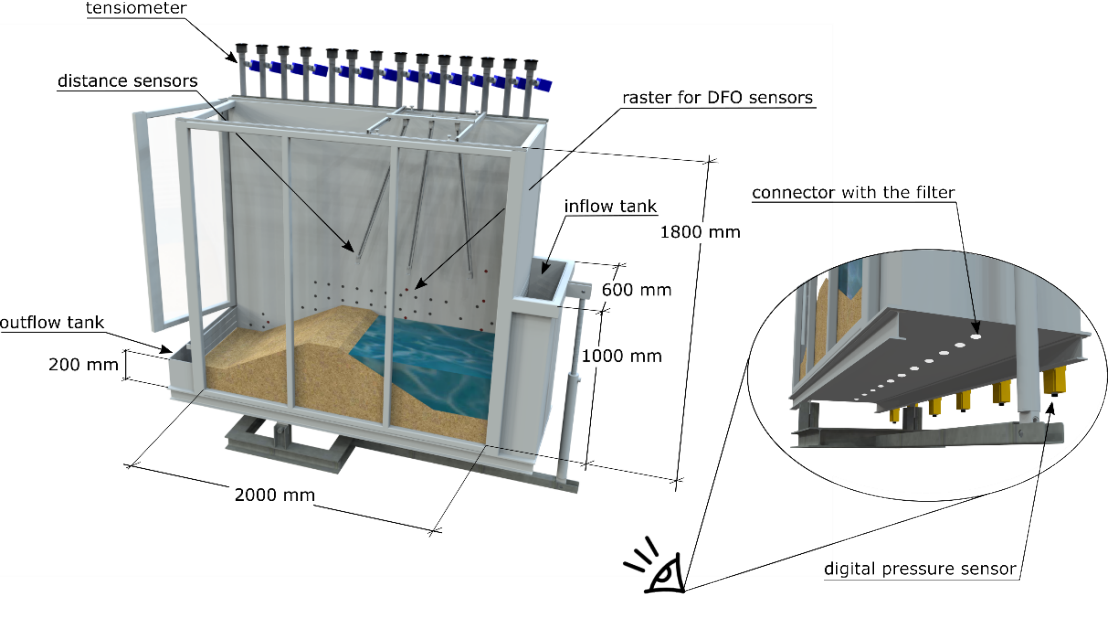
Geohydraulic earthen structures like reservoir dams and flood protection dikes play an important role in water resources and flood risk management. Their structural safety is becoming more crucial due to population growth, increasing urbanization density, and climate change. Depending on the severity of flood events, annual flood damage in Switzerland ranges from several million to billions of Swiss Francs.
One of the most common dam failure causes is internal erosion. The transport of soil particles by seepage flow through or within an earthen embankment forms small channels or “pipes”, which weaken the dam and may lead to failure. The main factor that causes internal erosion is seepage, which can be caused by permeable layers, cracks or fissures, animal burrows, vegetation roots, and human activity (i.e., drilling, vibration).
The most common method to detect internal erosion is by monitoring seepage anomalies through visual surveillance or measurements. Traditional measurement systems are not adequate due to their low spatial and temporal resolution, as geohydraulic structures can extend over hundreds of kilometers, and their failure can occur within a short time (hours) and at a very local scale (meters). Various measurement methods, based on electrical resistivity, self-potential (electrical), or seismicity, have been developed to improve spatial and temporal resolution. However, these methods are not fully automatic and not cost-effective when applied over long distances.
A promising monitoring technology that satisfies spatial and temporal requirements is the distributed fiber optics (DFO) technology. The first application in dams was attempted in Germany, where distributed temperature measured with DFO sensors was used to detect seepage anomalies. Another method involves measuring the distributed pore pressure. Recently, a distributed pore pressure sensor based on DFO technology was developed in Italy. However, this sensor cannot measure effective soil pressure and is not suitable for industrial production, which is essential for field installation.
Following the latest developments, the main objective of this research is to develop a new monitoring system and methodology based on DFO technology to identify, locate, and quantify in real-time seepage anomalies that may lead to internal erosion in dikes and dams. The key aspect of the research is the development of a new DFO soil and porous water pressure sensor that can be produced industrially and is suitable for implementation in real-world projects. The sensor will be calibrated in the laboratory, and later full-scale tested at an outdoor facility in Boretto (Italy) under hydraulic conditions resembling those at prototype structures. The collected data will be interpreted with analytical and numerical models. The developed monitoring system will constitute a valuable tool for risk assessment and provide critical information to river managers for their decisions on flood safety.
Link to the project website: external page https://fibradike.com/

Fish migrating downstream are exposed to a considerable risk of injury during turbine passages at hydropower plants. Electrified bar racks are a promising addition to traditional fish protection and guidance structures such as mechanical behavioural fish guidance bypass systems. The electric field induces an avoidance reaction, which prevents rack passages and thus turbine passages. Depending on the fish species, electric field strength, electrode placement, and electrical parameters such as pulse length and frequency, fish injuries may occur due to the electric field. The aim of this study is to examine electrified trash racks, which have shown promising fish protection efficiencies in laboratory tests, for a possible risk of injury to enable the implementation of pilot projects.
In the ethohydraulic flume at VAW, two trash racks with different electrode placements and bar spacings are evaluated. The racks are electrified with pulsed direct current (pDC) or pulsed alternating current (pAC) with different waveforms and field strengths. Two scenarios are tested: 1) interaction with the electric field upstream of the rack: rack passage is prevented, and the fish has the possibility to look for an alternative descent path, or 2) rack passage. Live-fish experiments are carried out with hatchery brown trout. Following the rack interaction, the fish are visually evaluated as well as pathologically and radiologically examined for internal injuries. This allows the evaluation of how different parameters affect the risk of injury and which configurations might be suitable for use at pilot sites.

Failures of spillway chutes at Dickinson Dam (1954), Big Sandy Dam (1983), and Oroville Dam (2017) were caused by hydraulic jacking of concrete slabs. This occurs when uplift forces exceed the slab’s weight, anchor capacity, and surface water pressure. A better understanding of the uplift mechanism and the development of a physically-based model are key for the safe design and sustainable use of spillways, sediment bypass tunnels, and other hydraulic structures prone to slab failure.
The project aims at advancing knowledge of the physical processes of turbulent flow characteristics, dynamic pressure distributions, and impact on the uplift of invert slabs in high-speed flows. Effects of flow velocity, channel inclination, vertical and horizontal offsets of the slab, sealed, partially and fully vented joints, invert roughness and flow aeration on the uplift of the model slab will be systematically investigated in a laboratory channel, simulating a dam spillway. Finally, a model will be developed to forecast uplift pressure and flow through offset joints and under the chute slabs for a range of conditions.
The knowledge gained from this project is of primary importance not only for dam operators, hydraulic engineers, and agencies dealing with dam safety (e.g. Swiss Federal Office for Energy, SFOE), but also for the research community on high-speed flows and design of hydraulic structures. The uplift pressure model will contribute to (1) better understand the uplift mechanism, (2) assess the failure risk of safety-critical hydraulic structures and take countermeasures, if needed, and (3) design, built, operate and maintain existing and new hydraulic structures.

The growing share of intermittent renewable energy sources such as solar and wind requires greater flexibility in power generation to ensure grid stability and security of supply. While storage hydropower plants have traditionally provided ancillary services, the flexibility potential of run-of-river hydropower plants (RoR HPP) remains largely untapped.
A pilot study at the RoR HPP Gletsch Oberwald in the Goms region of the Swiss Alps demonstrated that such plants can offer short term flexibility by temporarily using desanders and waterways as storage volumes. Under normal operation, turbine discharge corresponds to the natural inflow from the watershed. During periods of low discharge, however, temporarily turbining more than the natural inflow lowers the water level in the desander and power waterway, thereby enabling the use of existing hydraulic infrastructure as short term storage.
Building on this promising case, the SmallFLEX Goms project expands the concept to a fleet of RoR HPPs in the Goms valley, including the potential for coordinated operation of several RoR HPPs, or their integration with wind and solar assets into virtual power plants (VPP).
One limitation of using desanders and waterways as storage volume is the potential entrainment of air into the pressurized system when water levels are lowered, which is undesirable for both efficiency and safety. To assess this risk, the HPP Mörel is being investigated at VAW through physical model experiments. The 1:16 scale model extends from the final section of the free flow headrace tunnel, through the overflow chamber, to the first section of the pressurized headrace tunnel with both mildly and steeply inclined sections of the headrace tunnel. The experiments aim to qualitatively observe the effects of water level lowering, identify the different air entrainment mechanisms, and ultimately define the minimum allowable water level.

The revised Water Protection Act (Gewässerschutzgesetz) of 2011 requires, among others, the restoration of fish passability at transverse structures such as run-of-river hydropower plants. To improve downstream fish migration, guiding rack bypass systems are increasingly being used. These systems are intended to safely guide fish past hydropower facilities, although conventional rack types often involve hydraulic disadvantages. At VAW, the foil-shaped Curved-Bar Rack (fCBR) was therefore developed, which, due to its shape, offers improved hydraulic performancecombined with high fish-guiding efficiency.
At the Herrentöbeli hydropower plant on the River Thur, the fCBR bypass system was installed for the first time in Switzerland. In a pilot and demonstration study, the system was optimized in advance at VAW through numerical and (etho-)hydraulic model investigations. This project now focuses on field measurements for technical performance assessment. The aim of these investigations is to evaluate the flow conditions in and around the structure and to verify whether they meet the design criteria. Using an Acoustic Doppler Current Profiler (ADCP), flow velocities were measured in the approach flow, near the rack, and in the bypass.
The evaluations show that the design criteria for downstream fish passage at the Herrentöbeli pilot plant are largely met and that the results agree well with the numerical simulations.
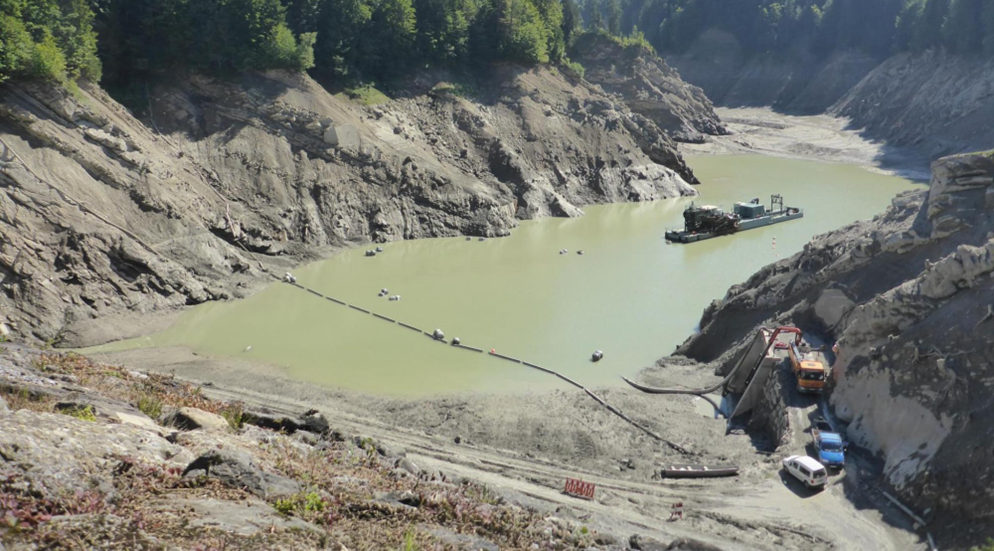
For decades, storage hydropower has been of great importance for the electricity supply in Alpine and adjacent regions. On one side, it generates electric energy, and on the other side, reservoirs allow to store energy. Given the increasing risk of winter supply shortages and the requirements of the future energy system, there is a high necessity of maintaining and extending hydropower capacities. However, large amounts of sediments are transported into hydropower reservoirs and deposited there every year (Fig. 1). The sedimentation leads to a loss of storage capacity and compromises the functionality and operational safety of hydropower intakes and outlet works.
One strategy to counter reservoir sedimentation is the so far rarely applied systematic venting of fine sediments via the power waterway of hydropower plants. Thereby, production losses and high suspended sediment concentrations, as typically occur during flushing, are avoided. However, the increased fine sediment load poses a challenge in terms of hydro-abrasive erosion on the turbines, reducing their efficiency and leading to lower electricity production. The costs of fine sediment venting depend, amongst others, on the maximum particle size and the maintenance strategy. These topics are addressed in a case study at the Bolgenach reservoir and the connected hydropower plant Langenegg in Vorarlberg, Austria.
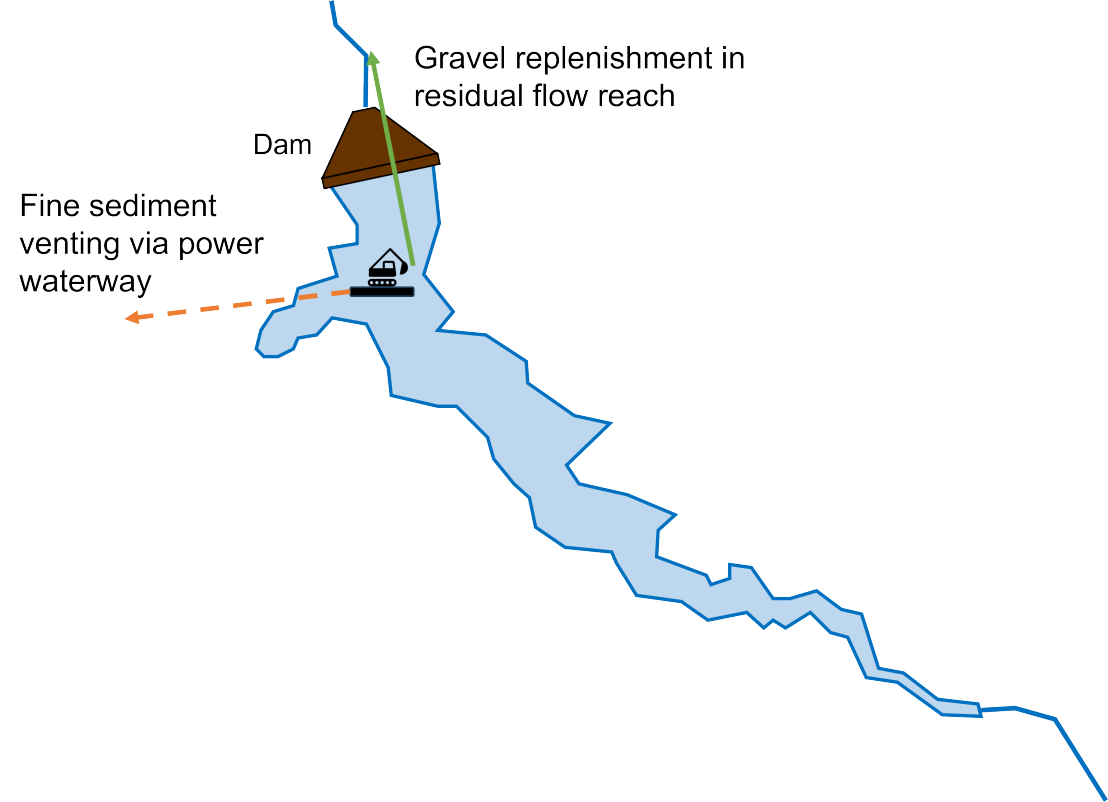
As part of the new sediment management system (Fig. 2), deposited sediments in the Bolgenach reservoir are dredged and sorted by size on board a vessel. Fine sediments are pumped to the intake and vented through the power waterway, through which they are delivered to the river reach downstream of the powerhouse. Coarse particles are transported to the bottom of the dam by a cable car, where they serve for sediment replenishment in the residual flow reach and thus for ecological improvement.
The fine sediment load of the turbines is quantified by measuring particle concentrations in real-time, in addition to particle properties like size, hardness, and shape. In parallel, the hydro-abrasive erosion at the Francis turbines of the hydropower plant and their efficiency are monitored. The study aims to optimize the venting process with respect to technical and economic aspects while complying with environmental regulations. In addition, the turbine erosion model according to IEC 62346 shall be further calibrated and validated. Using this model and based on the operation experience, the management and maintenance strategy will be improved.
Additional knowledge on fine sediment venting via power waterways of hydropower reservoirs contributes to the sustainable use of the hydropower potential and allows to better cope with sediment loads at reservoirs in the future considering climate change.
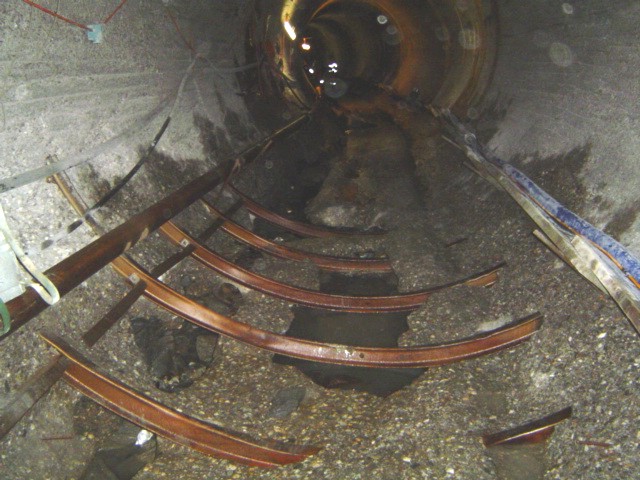
Worldwide thousands of dams impound rivers to create storage volume and thus regulate water for power plants, provide flood retention volume, ensure water supply for human consumption and make watercourse segment navigable. Due to the continuous sedimentation, the storage volumes reduce. Consequently, the versatile functions of the reservoirs and the operating safety or even the dam stability are endangered. Sediment bypass tunnels (SBTs) are an effective measure against reservoir sedimentation by diverting sediment-laden water past the dam and allow for re-establishing the natural sediment continuity. However, high-speed sediment-laden flows in SBTs can cause severe invert abrasion, which may reduce their cost-effectiveness and endanger the sustainable use of water and energy supply.
Abrasion prediction is essential for design life estimations, selection of adequate lining materials and cost-effectiveness analyses. Different mechanistic abrasion prediction models stemming from laboratory experimentation are available, whereas their applicability to field is scarcely investigated. Therefore, this project aims at calibrating and enhancing the abrasion models by quantifying abrasion resistance of various invert materials at three Swiss SBTs. As a prerequisite, sediment transport, hydraulics and hydroabrasion are monitored at Solis, Pfaffensprung and Runcahez SBTs. Furthermore, a Swiss Plate Geophone System for bedload monitoring is calibrated. The findings of the present pilot project will contribute to optimization of design and operation of SBTs as well as other hydraulic structures facing hydroabrasion. Finally, this project aims at contributing to a successful realization of the Swiss ‘Energy Strategy 2050’.
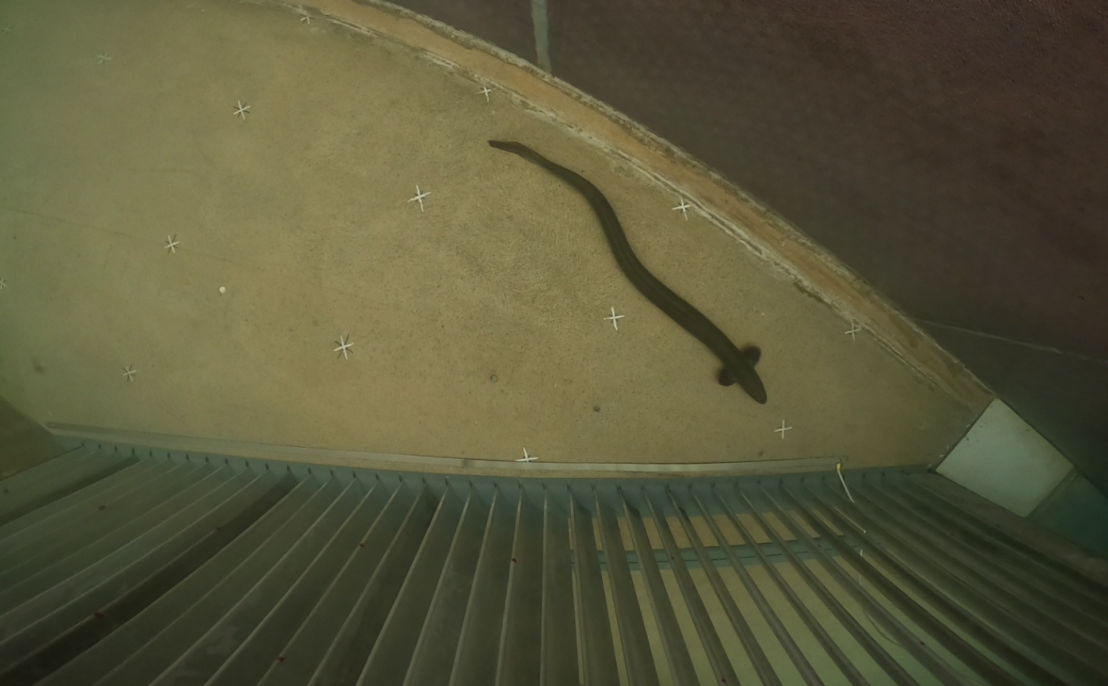
Hydropower plants interrupt the longitudinal connectivity in river networks, which hinders fish movement and puts downstream migrating fish passing through turbines or over weirs at risk to sustain considerable injuries and mortality. Especially the European Eel (Anguilla anguilla) is strongly affected with mortality per plant varying between 25% and 100%. Among other factors, this has led to a decline in fish stocks in recent years. The revised Swiss Waters Protection Act demands the revitalization of water bodies compromised by manmade structures by 2030. This includes the restoration of the ecological continuum and thus the unharmed passage of migrating fish and other organisms. While various technologies for upstream fish migration have been developed to the state where individual systems can be implemented at existing or new hydropower plants, downstream migration problems have been neglected and have to be addressed now as an urgent matter to stop the decline in the fish population.
Two research projects in the scope of the project “Fishfriendly Innovative Technologies for hydropower” (FIThydro), part of the Horizon 2020 EU Research and Innovation program were recently completed at the Laboratory of Hydraulics, Hydrology and Glaciology (VAW) of ETH Zurich. The first PhD focused on horizontal bar rack- bypass systems (HBR-BS) with a narrow bar spacing, which are effective fish protection structures for certain size of fish individuals.
In the second PhD project, a new mechanical behavioral bar rack- bypass system (Curved bar rack - bypass system, CBR-BS) was developed. It is an effective fish guidance structure (FGS) for a large number of species while permitting large bar spacings to reduce head loss and clogging. However, it does not work well for European eels and brown trout (Salmo trutta) as they react poorly to the generated hydrodynamic cues.
For this reason, VAW is developing electrified fish protection racks, with the aim to improve fish protection without compromising guidance at HBR and CBR. To this end, the racks are combined with a low voltage pulsed direct current, to incite an avoidance reaction similar to a pasture fence.
The objective of the experiments carried out at VAW is to improve the understanding of the interaction of fish behavior with different electrical field strength and pulse patterns at various hydraulic conditions.
This research project contributes to the sustainable and efficient usage of water power in Switzerland and Europe.
The present study is a continuation of the BFE project external page EthoMoSt, Etho-hydraulische Modellversuche an elektrifizierten Fischleitrechen.
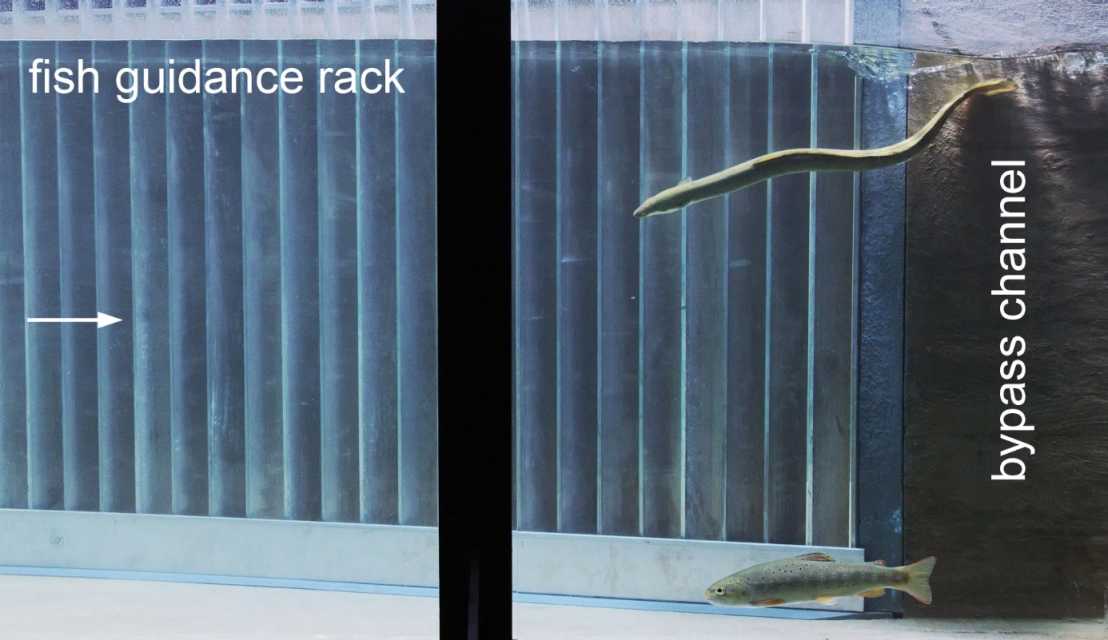
Hydropower plants (HPPs) and other barriers interrupt the longitudinal connectivity in river networks, which among others hinders downstream fish migration and puts fish passing through turbines or across weirs at risk to sustain considerable injuries or even mortality. Among other factors, this has led to a decline in fish stocks. For an efficient restoration of water bodies, several regulations have been introduced including the European Water Framework Directive and the revised Swiss Waters Protection Act and Waters Protection Ordinance. For almost 700 HPPs in Switzerland, downstream fish passage facilities must be upgraded or newly erected until 2030.
For certain fish species, fish guidance racks (FGRs) with adjacent bypass systems (BSs) are effective fish guidance structures for safe downstream fish passage at HPPs and water intakes. However, especially regarding the bypass systems, there are open questions related to its design and operation. This project aims at increasing the fish guidance efficiency of such systems for European key umbrella fish species by systematically investigating current bypass designs and developing an innovative bypass layout. The goal of the latter is to maintain hydropower production by minimizing bypass flow and/or using part of the bypass flow for electricity production. The key fish species are Atlantic salmon, European eel, barbel, European grayling, and brown trout. To reach the project goals, first numerical simulations of various bypass system designs and subsequently ethohydraulic experiments of optimum bypass designs will be conducted at VAW. Furthermore, the effects of sediments and floating debris on the operation of FGR-BSs will be evaluated and technical solutions to counter negative operational effects will be developed.
In parallel to the study of the BSs, hydraulic and biological performance of a Modified angled Bar Rack (MBR) will be evaluated in full-scale conditions at the case study HPP Laudal in Norway for Atlantic salmon by combining detailed fish monitoring with velocity measurements. This will provide crucial information on the behavior of fish under natural conditions when approaching and using guidance structures during their downstream migration.
Overall, this project will contribute to the further development of fish protection and guidance systems. On the one hand, the findings of the study can be used to supplement specific recommendations for the optimal design of fish protection systems and hence contribute to the fulfillment of the requirements set by legal regulations. On the other hand, the fundamental knowledge of swimming skills and behavior of a variety of fish species to hydrodynamics of river flow and FGR-BSs will be extended.
Downstream migrating fish in rivers pass multiple run-of-river hydropower plants (HPPs). Fish tend to follow the main flow and passage through turbine or spillway of the HPPs can result in high injury and mortality rates, which leads to a decline in fish populations. While some alternative fish guiding rack systems have shown promising results, there is a need to develop next generation systems that are cost-effective and easier to operate. In FishPath, we aim to find a completely new way of guiding fish past the water intake of power plants. Via their sensory systems, fish can detect turbulent movements (eddies) in the flow and respond either by avoiding them or by exploiting the eddies for swimming. Fish behavioral response to turbulent eddies will be used to develop guidance systems that create alternative migration pathways for fish around HPPs and other water intakes.
In the multi-disciplinary international FishPath project, led by the Norwegian Institute for Nature Research (NINA), these abilities will be utilized to develop a turbulent eddies based guiding structures for salmon, trout and eel. Therefore, eddies created by different objects (e.g., cylinders, hydrofoils) and how the fish species respond to different types of eddies will be explored. A turbulent Eddies-based behavioral fish Guidance System (EGS) based on a combination of such elements will be designed (Figure). Live-fish tests, and hydraulic measurements of single elements and selected EGS configurations will be conducted in etho-hydraulic flumes at VAW to explore the fish-eddy interaction and the guidance efficiency of turbulent eddies. Furthermore, VAW will contribute to the large-scale and full-scale tests of the EGS at the Laxelerator race-track flume at Vattenfall in Sweden and at River Mandal in Norway, respectively. In parallel, VAW will support the numerical study of single elements and EGSs by SINTEF.
